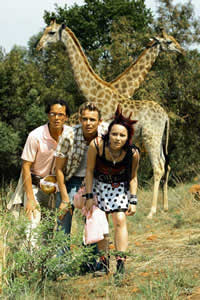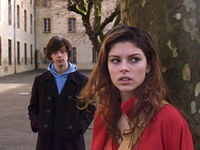Victims or brave heroines?

For a few years Holland has produced a remarkable amount of teenage movies about young girls and their problems in growing up. More than wherever in Europe. It almost seems like we came across a new genre in the Dutch film industry, although this doesn’t come out of the blue. Film journalist Leo Bankersen researched about the roots and social context of this phenomenon.
We shudder with abhorrence about the youth of today. Recent programs about the sexual behaviour of youngsters gained a lot of attention on Dutch television, including video clips in which scarcely dressed willing girls throw themselves at the feet of gold-blinged gangster types.

These are not just bogeys in the minds of moralistic parents. Research by Tom ter Bogt, professor in popular music and youth culture at the Utrecht University, proved that young girls (more than boys) are influenced by those video clips. After watching them they were more convinced about the importance of a sexy appearance and were more tolerant about the idea of having sex without a steady relationship. But the same research indicated that the majority of youngsters between 13 and 16 is very reluctant towards free sex.
Maybe we worry too easily. The same teenagers with a bad taste for video clips went to the cinemas last year to watch three movies propagating a very opposite image of youth. No romantic sexy fairytale but realistic, emotionally strong adventures of normal Dutch adolescents.
Mothers & Daughters

DESPERATE (Dave Schram) was made after a book by author Carry Slee who is tremendously popular amongst Dutch teenagers between 10 and 15 years. A young girl pushed by her mother towards a modelling career. As a result she becomes an anorexia patient. Two books by Carry Slee were adapted to the big screen before: XTC, JUST DON’T DO IT (Maria Peters) and TIMBOEKTOE (Dave Schram).
HOW TO SURVIVE MYSELF? (Nicole van Kilsdonk) is based on two books by the equally popular Francine Oomen. Rosa, a brooding girl trying to make friends in her new school, finds out imitating the class’ most popular girl is not the best way.
DUNYA & DESIE (Dana Nechushtan) deals with life’s big questions as posed by two bosom friends, the Dutch madcap Desie and the thoughtful, Morocco-rooted Dunya.
Last titles both scored about 200.000 viewers, XTC even 330.000, which is very satisfying in Dutch terms, considered the small target audience of (female) teenagers. To her surprise Dana Nechushtan found out many mothers came watching DUNYA & DESIE together with their daughters.

The audience was mainly female. No surprise considered the movie’s themes and the fact that girls read more books than boys (four out of five titles named are book adaptations). Although the attention in Carry Slee’s books is almost equally divided amongst both sexes. “Boys prefer buying a ticket for the next action movie,” stated a spokesman from production company Shooting Star.
Carry Slee & Francine Oomen
There must be reasons for this sudden booming of a new genre. DUNYA & DESIE is a spin- off from a TV-series (also directed by Nechushtan) that ran on television since 2002 while the other films were all backed by successful books. The Foreign Media Group, editor of the Carry Slee-books, together with film producer Shooting Star, developed a strategy for a series of adaptations. HOW TO SURVIVE MYSELF? was made in a similar way, after author Francine Oomen addressed producer BosBros.
Carry Slee published her first children’s book in 1989 and a new one came out almost every year. Like ‘XTC’ (1998) or ‘Desperate’ (2003), many of them were awarded by the Dutch Children’s or Youngsters’ Jury in the 13 – 16 years age group. So far 4 million Slee-books were sold, Carry Slee became a franchise. “An important reason for her success are the stories dealing with problems familiar to children, from their every day environment,” says a spokesman for the editor. Slee digs deep into heavy subjects such as divorce, suicide, addiction or homosexuality and handles them in a rather mature way.
Francine Oomen, children’s author since 1990, is more playful but she too addresses children at their own level. The main character in the ‘How to survive myself?’-series is the clever, creative but also insecure Rosa. Her stories are adorned with emails and MSN-messages in which Rosa shares her feelings. She constantly receives adolescence-survival advice from friends. The tone is witty, even when things might end up in a dramatic way.
The books by Slee and Oomen contain plenty of lessons for life, which is useful at an age when you won’t accept any advice from parents or teachers.
Kissing or sex?
In Slee’s books these lessons are rather emphatic, turning them sometimes into a catalogue of today’s teenage problems. Like a concerned grown up, focussing on all dangers threatening girls (and boys) during those turbulent years of adolescence. Melissa in ‘Afblijven’ is working as a dancer in a video clip when she gets under the spell of a smooth but dangerous boy bringing her in touch with drugs. Luckily she survives, thanks to one sweet boy who’s willing to go through fire and water for her. Yara (‘Desperate’) suffering from anorexia is another teenage girl in danger.

‘ Love’ is always involved, but sex stays out of the picture. For these teenagers the first kiss offers enough excitement already, and that might as well be pretty realistic.
Only DUNYA & DESIE takes it one step further. Being 18 already, the girls are self-assured and enterprising, although life is still confusing for them. The impulsive Desie misunderstood the signals from her boyfriend and got pregnant from an unreliable motoring instructor who’s now backing out as fast as he can. What follows is a joyful, colourful and emotional road movie in which Desie and Dunya travel through Morocco, hoping to find answers to their many questions. Also a sort of lessons for life, but less obligato. The tone and atmosphere are much more of a comedy for grown ups than of a teenager movie. Nechushtan deliberately didn’t want to make a problem-based movie. “This should be a film about friendship.” DUNYA & DESIE was screened in dozens of festivals (including Berlin) and was recently released in Japan.
Zoop & Co
Stories from the world of teenagers with common characters alike the youngsters they meet at school – it’s a rather new phenomenon. Burny Bos from BosBros, producer of HOW TO SURVIVE MYSELF? and many other youth films, states that over the last years Holland gained a strong position in this specific field. It started with family films. Then young children were discovered as a potential cinema audience. Now the teenagers are included as well. About his own role Bos says: “We want to create something that makes sense. Films dealing with realistic topics and emotions.”

Films by producer and director Johan Nijenhuis are playing in another league. Light-weight films, but an unmistakably important element in the Dutch movie supply for teenagers.
In 2001 Nijenhuis debuted with COSTA!, a movie about beaches and discotheques with a pinch of romance. The critics didn’t save a single positive word for such low budget exploitation cinema, made by a director schooled in television soaps. But COSTA! became Holland’s most successful film of the year and the teenage audience learned an important lesson from it: Watching a Dutch movie can be fun!
Later a series of successful titles targeting the same audience followed. Nijenhuis shot a series of three TV-spin-offs for an 8 – 14 years audience. In ZOOP IN AFRICA and its sequels a bunch of young zoo employees get involved in adventures with crooks and wild animals in far away locations.
Compared with films like DESPERATE, Nijenhuis’ films are completely unrealistic. But the ZOOP-films’ charm can be found in the enthusiastic summer camp atmosphere and the heroes and heroines being, in spite of the clichés and exaggerations, simple boys and girls. In spite all stereotypes the ZOOP films are still rather emancipated. You don’t have to be a boy to act tough, even the vain Bionda can hold her own if needed.
Delicate
The line between teen movies and movies about teenagers made for a grown up audience is sometimes very thin. Wrestling with puberty and sex was pictured in a moving sobering way in DEEP (Simone van Dusseldorp, 2005), about a 14 year old daughter from liberal parents, expecting her defloration to be such a relief.
KATIA’S SISTER (Mijke de Jong, 2008) is even more delicate. A subtle portrait of a lonely 13 year old girl, daughter of a prostitute and sister of a stripper. De Jong already proved her fascinating view on the world of adolescents in BLUEBIRD, a dead sharp and poignant story about a 12 year old girl getting bullied. Parents watching such films immediately do get worried. But… No problems, no drama…
Leo Bankersen
(Dutch freelance film journalist)
